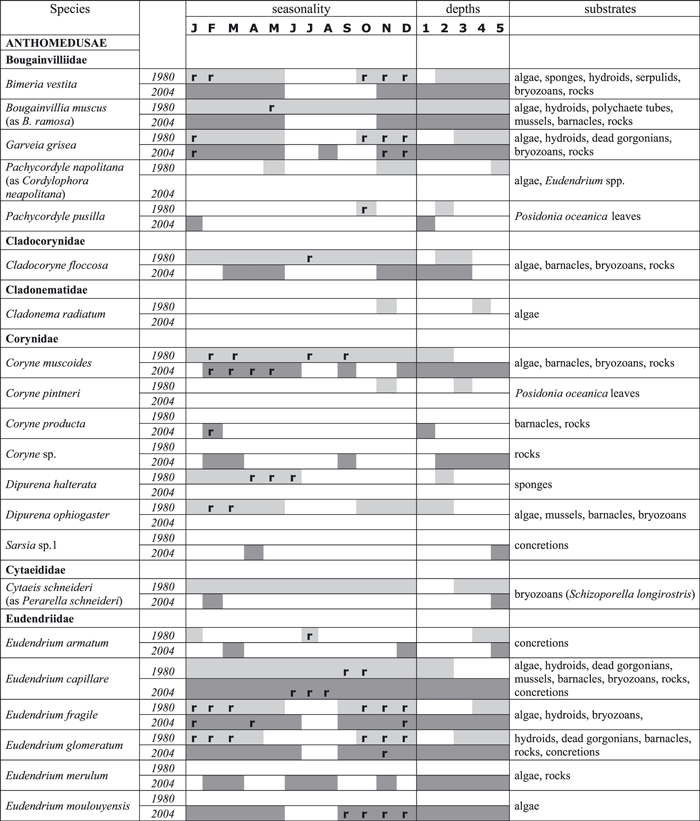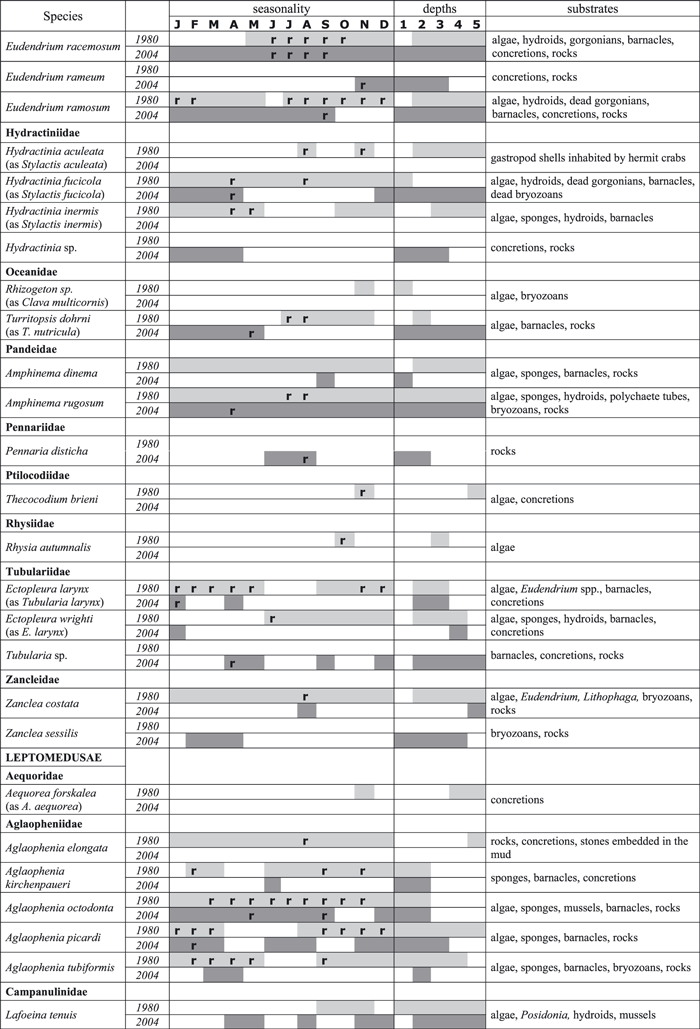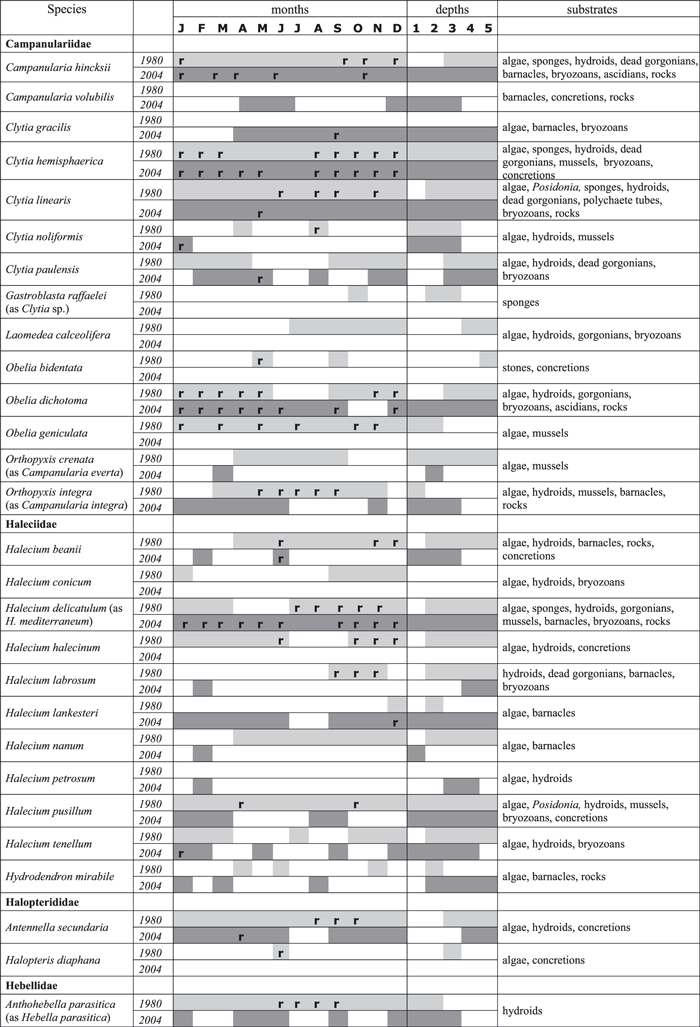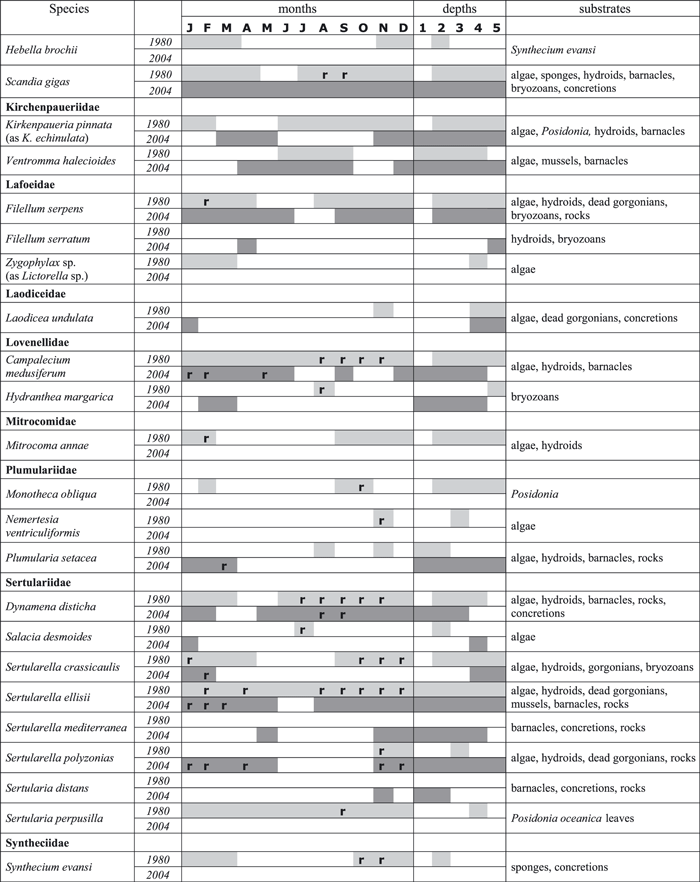Long-term changes in hydroid (Cnidaria, Hydrozoa) assemblages: effect of Mediterranean warming?
Abstract
Marine hydroids are markedly seasonal in temperate seas, being extremely sensitive to climatic changes disrupting seasonal patterns. Modifications in the composition, seasonality, bathymetric distribution and reproductive period of hydroid assemblages are useful to evaluate the influence of global warming on the marine ecosystem. The hydroids on the rocky cliff of the Portofino Promontory (Ligurian Sea, Italy) were carefully studied between 1976 and 1983; in particular, in 1980 the study was carried out along a vertical transect. The hydroids were sampled again throughout 2004, with the same techniques and along the same transect. Species diversity decreased slightly in the 2004 survey. Some species present in 1980 had disappeared in 2004, but other species with southern affinity, never recorded from the area, became abundant in 2004. Species that were present in summer in the first period were also present in winter in the second one. Furthermore, shallow summer species widened their bathymetric distribution, reaching deeper levels. These data strongly suggest that the Portofino hydroid assemblage reacted to the water temperature increase found in the Mediterranean Sea.
Problem
The Mediterranean Sea lies within the warm-temperate marine region ranging from the northwestern coast of Africa to the entrance of the English Channel (Briggs 1974; Vermeij 1980). The most typical Mediterranean biota lives in the Tyrrhenian Sea, the central sector of the Western Mediterranean, with the most endemic species, Atlanto-Mediterranean elements, and a fairly high percentage of species with subtropical affinities (Bianchi & Morri 1993). North of the Tyrrhenian Sea, in the Ligurian Sea, waters are colder and the subtropical element is markedly lower in importance, whereas species from cold-temperate waters are present, giving the Ligurian Sea a boreal affinity (Rossi 1969; Albertelli et al. 1981; Cattaneo-Vietti et al. 1988). Southern, warm-water species have been sparsely reported from the Ligurian Sea, but their survival in cold years is unlikely, explaining the rarity of records. In a few cases warm-water species have succeeded in establishing adult pseudopopulations unable to reproduce (Bianchi & Morri 1994; Bianchi 1997). Nevertheless, Bianchi (1997) hypothesized that present sea-water warming is allowing former sterile pseudopopulations to reproduce in the Ligurian Sea, thus providing independence from the larval supply by the Tyrrhenian Current and allowing the establishment of stable populations of warm-water species. For example, Sara et al. (2005) documented the mating behaviour of the warm-water labrid fish Thalassoma pavo in this area.
Substantial evidence demonstrates that the climate is changing and that the average surface temperature of the sea is increasing (Bianchi 1997; Marullo & Guarracino 2003). Grainger (1992) predicted that this global warming would probably make southern species extend their range northward. This prediction proved correct in the Mediterranean Sea, where there has recently been an increase in warm-water pelagic fish and benthic organisms in the northern sectors, such as the Ligurian Sea (Bianchi & Morri 1993, 1994, 2003, 2004; Francour et al. 1994; Astraldi et al. 1995; Bianchi 1997, 2007). Bianchi & Morri (1993, 1994) provided a list of 20 southern epibenthic species in the Ligurian Sea, including algae, sponges, cnidarians, molluscs, crustaceans, echinoderms and fishes, suggesting that the occurrence of warm-water species is linked to year-to-year climatic variability, rather than to the establishment of a permanent ‘thermophilic oasis’. Summer temperatures are particularly high in shallow waters, a surface thermocline separating them from colder deeper waters. Most sessile species of cold water affinity cannot stand high summer temperatures: seasonal ones simply become inactive in the summer, often remaining active below the thermocline, whereas perennial species can live only under the thermocline. The deepening of the surface thermocline therefore clearly affects the presence and distribution of cold-water species (Boero et al. 2003). Mass mortalities of sponges and gorgonians in the Ligurian Sea are most probably due to this type of impact (Cerrano et al. 2000; Garrabou et al. 2001).
Southward (1995) identified the lack of ‘historical’ long-term data as the major problem in relating fluctuations of marine communities to climate changes. Fishery statistics often provide the longest available time series of biological data (Glantz 1992; Laevastu 1993). Long-term series are also available both for plankton (e.g.Robinson & Hunt 1986; Maddock et al. 1989; McGovan 1990; Cataletto et al. 1995; Degobbis et al. 1995; Molinero et al. 2008) and the benthos (e.g.Ambrogi et al. 1994; Shillaber 1995; Fromentin et al. 1997) but datasets are scarce (Cabioch et al. 1983; Warwick & Bayne 1993). In the case of the benthos, most time series have been studied only for the last few decades (Heip et al. 1987; Keegan 1991), although Blacker (1957) was already considering benthic organisms as indicators of climatic change.
The hard-bottom macrobenthos is made up of both slow- and fast-growing organisms and its composition varies mainly in relation to substrate competition. Hydroids are an important macrobenthic group that undergoes sharp seasonal cycles (Boero 1984; Boero & Fresi 1986; Calder 1990; Gili & Hughes 1995; Bavestrello et al. 2006; Di Camillo et al. 2008) especially in the Mediterranean, a markedly seasonal sea whose summer and winter faunas have different zoogeographical affinities and ecological requirements. The great differences in the hydroid species found at a given place according to the season become clear when considering that polyps can become encysted as resting hydrorhizae under adverse conditions (Boero et al. 1986, 2003). The available data suggest that a mosaic of physical factors, biotic interactions, and internal clues triggers the hydroid cyclic behaviour (Brock 1974; Boero & Fresi 1986; Arillo et al. 1989; Bavestrello & Arillo 1992; Bavestrello et al. 2006), water temperature probably being strongly involved.
In the period 1976–1983 the most detailed study on a Mediterranean hydroid assemblage was carried out on the rocky cliff of the Portofino Promontory (Ligurian Sea, Italy) (Boero & Fresi 1986). In particular, during 1980, the hydroids were collected monthly along a vertical transect from 0 to 20 m subdivided into five depth ranges: 83 species were identified and their zonation pattern and the seasonal variations in their abundance and reproductive activity were reported (Table 1). The population dynamics of one of the most important hydroids in the area, Eudendrium glomeratum, were studied throughout 1983, helping to unravel the mechanisms of hydroid appearance and disappearance according to the season (Boero et al. 1986).
The above-mentioned bulk of records represent an historical database on the hydroid biodiversity of the Ligurian Sea; the current new work aims at studying the same hydroid assemblage after more than two decades (2004), following identical sampling methods, to reveal possible changes in species composition, zonation and seasonality.
Seven years of observation (1976–1983) revealed a quite constant pattern in the seasonal dynamics of hydroid populations as most species are probably long-lived, as demonstrated for Eudendrium glomeratum, even if their patterns of presence do not suggest so. A colony, in fact, remains viable for many years due to the permanence of hydrorhizae during adverse seasons.
Therefore this study was aimed at evaluating whether the presence, seasonality and vertical distribution of warm- and cold-affinity hydroids changed according to the parallel documented warming of the Ligurian Sea.
Material and Methods
The sampling techniques were identical to those used by Boero & Fresi (1986). Samplings were conducted monthly, throughout 2004, by SCUBA diving on a rocky cliff on the northern side of the Portofino Promontory, situated in the centre of the Ligurian Sea (NW Mediterranean Sea, Italy) (Fig. 1). The rocky cliff, in the locality named Aurora, is almost vertical to a depth of 10 m and then begins to slope with a number of large steps. The transect, marked by an iron chain, was subdivided into five depth zones (0–0.5, 0.6–5, 5.1–10, 10.1–15 and 15.1–20 m). Along the transect, hydroids were collected monthly by visually oriented sampling. Boero & Fresi (1986) first studied a series of standard samplings from 20 × 20 quadrats carried out in November 1976, but it became immediately apparent that this technique did not lead to an efficient representation of species diversity and that, furthermore, species composition changed almost monthly, especially for reproductive periods of the various species. Boero & Fresi (1986) compared the yield of traditional sampling with that of visually oriented sampling, showing that the two techniques were almost equivalent in terms of species yields but that visual samples were advantageous in terms of processing. The nomenclature used here is based on Bouillon et al. (2004, 2006).
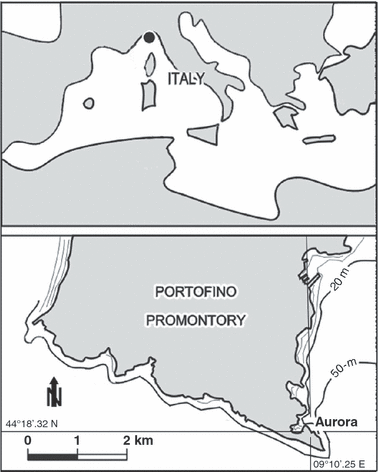
Map of Portofino Promontory in the centre of the Ligurian Sea.
Temperature regime in the studied area
Unfortunately, long-term temperature measurements are not available for the Ligurian Sea. The only records refer to air temperatures in the area of Genoa, close to the Portofino Promontory. To obtain a general scenario of the temperature variation in the studied area in the last 50 years we correlated the average annual surface water temperatures available for Genoa harbour from 1999 to 2006 with the air temperature obtained in the same place for the same period (n = 9; r = 0.92). Using this correlation we inferred the annual sea surface temperature from 1960 to 2006 and we plotted the thermal anomalies of each year on the average value obtained for the entire series (Fig. 2). Of the 17 years from 1960 to 1980, 12 show negative thermal anomalies until 0.7 °C. The situation remains similar until 1988 when a period of 3 years showed temperatures about 0.5 °C higher than the mean and from 1997 to 2004 with a long series of very warm years.
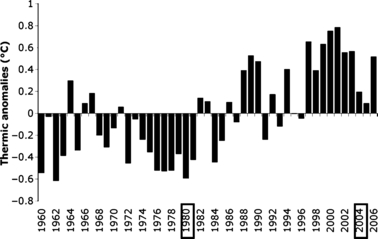
Thermal anomalies in the estimated average annual temperatures of the surface sea water on the average temperature of the last 50 years.
These data agree with the trend in the average water temperatures of the Tyrrhenian Sea showing, from 1985 to 2003, an increase of about 0.5 °C (Marullo & Guarracino 2003). During this period some particularly intense thermal anomalies were recorded in the late summers, particularly in 1999 and 2003 (Bavestrello et al. 2000; Marullo & Guarracino 2003; Schiaparelli et al. 2007), affecting the water column almost to 30 m depth, with temperatures 2–3 °C higher than normal.
Results
The total number of hydroid species recorded in the area of the Portofino Promontory is 119: 98 species were recorded during both the studies carried out along the Aurora transect during 1980 and 2004 and this bulk of data represents the basis of the following analysis (Table 1). Moreover, examination of the literature on Ligurian Sea hydroids and other unpublished records has revealed the existence of a further 21 species on the Portofino Promontory and surrounding coasts (Table 2).
| species | seasonality | depth (m) | substrates | references |
|---|---|---|---|---|
| Anthomedusae | ||||
| Bougainvilliidae | ||||
| Dicoryne conybeari | 10–25 | gastropod shells | Bavestrello (1985) | |
| Corynidae | ||||
| Coryne eximia | October–March | 0–25 | iron chains | Puce et al. (2003) |
| Cladonema sp. (as Sarsia sp.) | summer | 5 | sponges | Boero & Fresi (1986) |
| Cytaeididae | ||||
| Cytaeis propagulata | March–May | 2–10 | gastropod shells | Bavestrello (1987) |
| Eudendriidae | ||||
| Eudendrium simplex (as Eudendrium motzkossowskae) | always present | 0–1 | Posidonia leaves | Boero & Fresi (1986) |
| Hydractiniidae | ||||
| Hydractinia areolata | Saràet al. (1978) | |||
| Hydractinia exigua | Saràet al. (1978) | |||
| Oceanidae | ||||
| Corydendrium parasiticum | summer | 10–20 | rocks, artificial substrate | unpublished |
| Pandeidae | ||||
| Neoturris pileata | January–March | 15–25 | gastropod shells | Bavestrello (1985) |
| Paracorynidae | ||||
| Paracoryne huvei | winter | 0–1 | rocks, mussels | Boero & Fresi (1986) |
| Ptilocodiidae | ||||
| Hydrichthella sp. | summer | gorgonian | unpublished | |
| Leptomedusae | ||||
| Aglaopheniidae | ||||
| Aglaophenia harpago | always present | 2–30 | Posidonia leaves | Boero & Fresi (1986) |
| Lytocarpia myriophillum | July | 40 and more | mud | Boero & Fresi (1986) |
| Campanulinidae | ||||
| Cuspidella sp. | April | 25 | concretions | unpublished |
| Halopterididae | ||||
| Antennella siliquosa | Rossi (1961) | |||
| Halopteris liechtensternii | Rossi (1961) | |||
| Hebellidae | ||||
| Hebella scandens | Saràet al. (1978) | |||
| Lafoeidae | ||||
| Acryptolaria conferta | Rossi (1949–50) | |||
| Plumulariidae | ||||
| Nemertesia antennina | July | 40 and more | mud, stones | Boero & Fresi (1986) |
| Phialellidae | ||||
| Phialella quadrata | winter | 100–120 | Pteria hirundo | Bavestrello (1983–84) |
| Tiarannidae | ||||
| Modeeria rotunda | winter | 100–120 m | Pteria hirundo | Bavestrello (1983–84) |
The comparison between the data obtained during 1980 and 2004 showed that the number of species was slightly lower (71) in 2004 than in 1980 (82) (Table 1). The number of anthomedusan species is identical (30), whereas Leptomedusae are less numerous (41 species in 2004 versus 52 in 1980) (Table 1).
Species composition, furthermore, is noticeably different in the two periods studied: 26 species collected in the reference period had disappeared (10 Anthomedusae and 16 Leptomedusae), and 16 species are new for the considered zone (10 Anthomedusae and 6 Leptomedusae). In particular, some Corynidae and Aglaopheniidae, very abundant in shallow water during 1980, had disappeared in 2004 (Dipurena halterata, Dipurena ophiogaster) or were drastically reduced (Coryne muscoides, Aglaophenia kirchenpaueri, Aglaophenia tubiformis). Conversely, in 2004 several never recorded species were collected (for instance Eudendrium moulouyensis, Pennaria disticha and Clytia gracilis) or were reported as more abundant (Sertularella polyzonias and Halecium lankesteri).
The number of species present on the cliff during 2004 varied seasonally. Values were high during winter (January–April), with a maximum in February (46 species), then gradually decreased in May (37 species), reaching the minimum in August (26 species), to increase again in autumn (Fig. 3A). The seasonal trend in 1980 overlaps that of 2004 from January to May, whereas from June to December species numbers are higher than in 2004. In November 2004, the species number is half that recorded in the reference period (Fig. 3A).
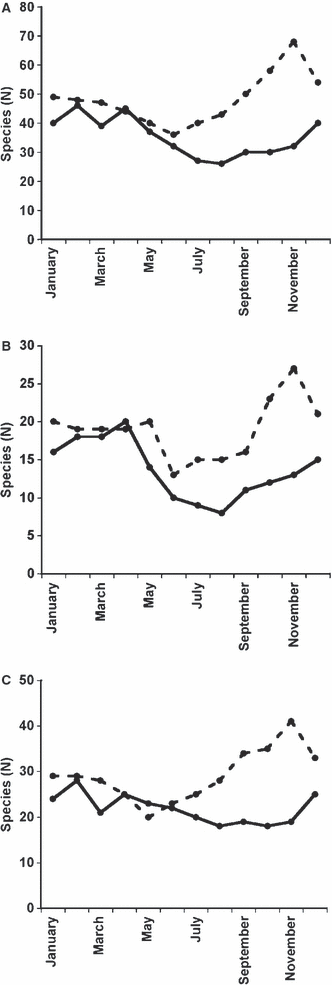
Number of species along the annual cycle during 1980 (dotted line) and 2004 (continuous line). (A) Total species, (B) Anthomedusae, (C) Leptomedusae.
The numbers of anthomedusan and leptomedusan species identified in 2004 and in 1980 along the annual cycle follow a similar trend to that of the total hydroid assemblage: from December to May the trends in both groups overlap those of 1980, with a strong reduction in species number in summer and autumn 2004. Unlike Anthomedusae, the decrease in the leptomedusan species begins in July (Fig. 3B, C).
The trends in fertile species percentages are similar in both periods. In 2004, the reproductive activity is lower, particularly during the summer (Fig. 4).
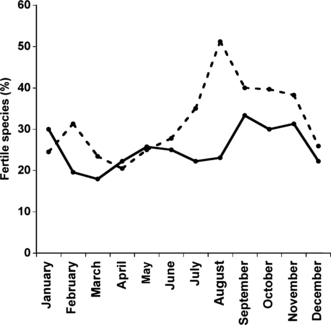
Percentage of fertile species along the annual cycle during 1980 (dotted line) and 2004 (continuous line).
Considering the period of presence of the species, the situation in 1980 was characterised by two main categories: species present only in 1 month (17%) and species present throughout the year (26%). During 2004, the percentage of species present during 12 months is strongly reduced (10%), whereas that of species recorded only in 1 month increased (21%) (Fig. 5).
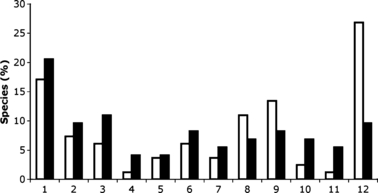
Percentage of species present in one or more months during the sampling in 1980 (white bars) and 2004 (black bars).
Past and recent seasonal distributions were markedly different: 40% of the species recorded only during spring–summer in 1980 had disappeared in 2004, 40% of them were active during autumn–winter, few showed a widened activity period and none remained active only during the spring–summer period (Fig. 6). Conversely, more than 70% of the autumn–winter species found in 1980 had disappeared, whereas about 12% had an unmodified or widened activity period and none were active during the spring–summer period (Fig. 6). Of the species recorded all year round during 1980, 54% were also present throughout 2004, whereas about 25% of them had disappeared, 18% were active during the cold period and 4% during the summer (Fig. 7).

Percentage of species showing a spring–summer or autumn–winter distribution during 1980 that had disappeared, maintained or changed their temporal distribution during 2004.
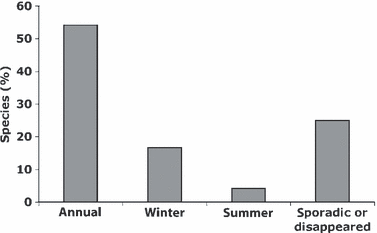
Percentage of species recorded all year round during 1980 that had disappeared, maintained or changed their temporal distribution during 2004.
The bathymetric distribution analysis reveals an increase in the number of species recorded at each depth in 2004 (Fig. 8): in fact, whereas in 1980 the species were mainly distributed at a single depth level, in 2004 almost 40% of the species colonized all the studied depths (Fig. 9). Of the species recorded only in shallow water (0–5 m) during 1980, 27% had disappeared, 20% showed an unmodified distribution, and more than 50% had widened their distribution (Fig. 10). On the other hand, 60% of the deep species in 1980 had disappeared in 2004, about 30% showed an unmodified distribution and less than 10% showed a widened distribution (Fig. 10).
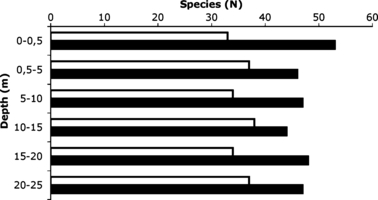
Number of species present at each depth level during the sampling in 1980 (white bars) and in 2004 (black bars).
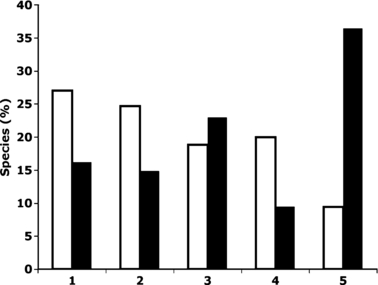
Number of species present at one or more depth levels during the sampling in 1980 (white bars) and 2004 (black bars).

Percentage of species recorded during 1980 exclusively in the shallow (0–5 m) and deep (10–20 m) stations that had disappeared, maintained or enlarged their bathymetric distribution in 2004.
Eudendrium capillare, a typically shallow-water species, was found at 20 m in 2004. Moreover, Aglaophenia elongata, generally collected at 15–20 m in 1980, had completely disappeared from this depth in 2004 and was observed only at deeper levels.
Several species modified both their bathymetric and seasonal distribution. Hydractinia fucicola, typically present in 1980 all year round at the depth level 0–0.5 m, was collected in 2004 exclusively during the winter and never at this depth, only from 5 to 20 m. Similarly, Plumularia setacea and Turritopsis dohrni, collected in 1980 during summer–autumn at 0–5 m, in 2004 became a winter species, reaching 20 m depth. Although Bougainvillia muscus and Kirchenpaueria pinnata show an unmodified bathymetric distribution, they changed their seasonality, disappearing during summer. Moreover, Eudendrium racemosum, a typical summer–autumn species, was also collected between January and March in 2004.
Discussion
The response of the hydroid species assemblage shows marked differences in the two studied periods, with a consistent trend favouring warm-water species and disfavouring cold-water species.
The species number for the two periods is very similar during winter–spring months (January–June), but clearly decreased during summer and autumn (July–December). In 2004, bathymetric distributions became wider, being unidirectional from shallow to deep water: almost 30% of the shallow water species had disappeared and more than 50% had gone deeper. More than 60% of deep-water species had disappeared. Only a few deep-water species (< 10%) rose towards the surface, maybe colonizing the substrate freed by some of the species which had disappeared.
Considering the whole transect, the number of observed species in 2004 was lower than that recorded in 1980; conversely, for each depth zone the number of observed species was higher in 2004 than in 1980. This is due to an increased number of species able to live at each of the depth zones, producing a homogenization in the composition of the assemblage along the depth gradient and the loss of exclusive species. Problems of biotic homogenization driven by climate change have already been discussed in recent papers, even for the marine environment (Olden & Rooney 2006; Bolam et al. 2008).
In 1980 a large percentage of species (about 25%) were active all year round, whereas in 2004 they were drastically reduced, having partially disappeared. The remaining species mainly restricted their active period to winter. A unidirectional shift in the activity period from the warm to the cold season was observed: most of the species that in 1980 were active during autumn or winter had disappeared, and half of the spring–summer species were also active in the cold season.
Moreover, in 2004 numerous species that were abundant in 1980 were not found, whereas species rare in 1980 were common and widely distributed in 2004. Hydroids typical of the Southern Mediterranean were recorded for the first time in the area studied: Eudendrium moulouyensis, a species originally described from Morocco (Marques et al. 2000) and recently observed in Southern Italy (De Vito et al. 2008) was frequent and reproductive. Pennaria disticha, very common in the southern part of the Tyrrhenian Sea, and sporadically recorded in the Ligurian Sea (Bianchi & Morri 1994), became actually extremely abundant at 0–5 m during summer.
Conclusions
Many observed patterns of temporal and spatial distribution consistently suggest that the Portofino hydroid assemblage has changed as a response to an increase in water temperature, although is not possible to completely exclude the influence of other causative agents (e.g. an increase in water pollution). Shallow-water species colonized deeper zones; deep-water species shifted to deeper levels; many winter species disappeared; many species shifted their activity period from summer to winter; southern species extended their range toward the Ligurian Sea.
Due to their ubiquitous presence and the tendency to form habitats for other species, marine algae are often used to describe the general conditions of coastal marine systems, also using particular indexes. Algae, however, are mostly abundant in the spring–summer, so that indexes, such as the Carlit index, are only informative if performed in this period (Ballesteros et al. 2007;Mangialajo et al. 2007). Hydroids are the counterpart of algae in the cold season, being sharply seasonal in appearance, and having the possibility to form habitats for other species. Following the work by Boero & Fresi (1986) this study shows that hydroids, due to their marked seasonality in temperate seas, are extremely sensitive to climatic changes and strongly suggests that the modifications observed in the composition, seasonality, bathymetric distribution and reproductive period of hydroid assemblages must be considered in the evaluation of the influence of global warming on marine ecosystems.
Acknowledgements
Financial support was provided by MIUR (PRIN project), by the Euro-Mediterranean Centre for Climate Change (CMCC), by the European Union (SESAME project, MARBEF Network of Excellence).



